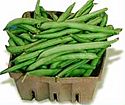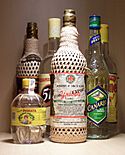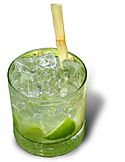Brazilian cuisine is super diverse, just like the country itself! It's a delicious mix of flavors from Portugal, Africa, Native Americans, and many other countries like Spain, France, Italy, Japan, and Germany. Because Brazil is so huge and has so many different people, each region has its own special dishes. This makes Brazilian food a really unique and tasty adventure!
| Name |
Image |
Description |
| Abará |
 |
Abará is made from the same dough as acarajé, using black-eyed peas. The main difference is that abará is steamed, while acarajé is fried. |
| Aberém |
|
This cookie from Bahia has African-Brazilian roots. It's made from ground corn or rice, mixed with water and salt, then cooked in dried banana leaves. |
| Acarajé |
 |
Acarajé is made from peeled black-eyed peas, shaped into a ball, and deep-fried in dendê (palm oil). It's a popular street food in Brazil's northeastern state of Bahia, especially in Salvador. |
| Acaçá |
|
This is a steamed porridge made from coconut milk and rice flour. |
| Arabu |
|
A unique Brazilian dish that includes raw (or lightly cooked) turtle eggs, served with cassava flour and a bit of salt. |
| Arrumadinho |
|
This dish is made with cassava or jerky, farofa (toasted flour), vinaigrette, green beans, and seasoned with clarified butter. |
| Bauru |
 |
A popular Brazilian sandwich. It usually has cheese (like mozzarella) melted in a special way, slices of roast beef, tomato, and pickled cucumber, all in a French bun with the soft inside removed. |
| Bolacha sete-capas |
|
This cookie has seven thin layers of dough, made with wheat flour, coconut milk, butter or margarine, and vegetable fat. |
| Bolinho |
|
"Bolinho" means "little cake" or "dumpling." There are many types, like codfish cakes (bolinho de bacalhau), rain cakes (bolinho de chuva), and cheese balls. |
| Broa |
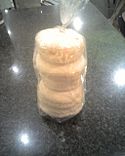 |
A type of cornbread, often seasoned with fennel in Brazil. It's also traditional in Portugal and Galicia. |
| Cabeça de galo |
|
From northeastern Brazil, this dish is a broth made from cassava flour with eggs and spices, especially pepper. It can also include ingredients like tomato and onion. |
| Cabidela |
 |
This dish is made with poultry or rabbit. The animal's blood is collected and used to cook the rice with the meat, giving the dish a unique grayish-brown color. |
| Cachorro-quente |
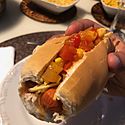 |
In Brazil, hot dogs are usually served in a bread roll with a tomato-based vegetable broth, corn, and potato sticks. |
| Catupiry |
 |
One of Brazil's most popular processed cheese brands. It's similar to cream cheese and was created by an Italian immigrant in 1911. |
| Chana |
 |
Chickpeas are also known as garbanzo beans. |
| Coxinha |
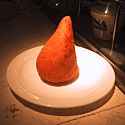 |
Meaning "little chicken thigh," this is a popular snack in Brazil. It's made from dough (with wheat flour and chicken broth) filled with spiced chicken meat. |
| Deep-fried cassava |
 |
Fried cassava (also called mandioca, aipim, or macaxeira) is a common substitute for French fries in Brazil. It's often served in bars with beer. |
| Farofa |
 |
A toasted manioc (cassava) flour mixture. In Brazil, it's often toasted with butter, salt, and bacon until golden brown. It's a must-have side dish for feijoada. |
| Ginga com tapioca |
|
A traditional food from Natal, Rio Grande do Norte. It's made of fried fish served inside Brazilian tapioca. |
| Misto-quente |
 |
A simple hot ham and cheese sandwich on sliced bread, often pressed until warm. |
| Pamonha |
 |
A traditional Brazilian food. It's a paste made from fresh corn and milk, boiled inside corn husks, like a dumpling. Some versions use coconut milk. |
| Pão de queijo |
 |
A small, baked, cheese-flavored roll. It's a very popular snack and breakfast food all over Brazil, especially in Minas Gerais. These rolls are unique because they're made from cassava or corn flour, making them chewy inside with a crispy crust. |
| Pastel |
 |
A fast food dish with thin pastry envelopes wrapped around different fillings, then deep-fried until crisp. Common fillings include ground meat, mozzarella, chicken, or shrimp. |
| Queijo de coalho |
 |
A firm, light cheese from Northeastern Brazil. It has a slightly "squeaky" texture when you bite into it. It's a popular beach snack, often grilled by vendors. |
| Queijo Minas |
 |
A type of cheese traditionally made in the Brazilian state of Minas Gerais. It comes in different forms: fresh (frescal), slightly aged (meia-cura), and aged (curado). |
| Quibebe |
|
A winter squash soup that comes from Northeastern Brazil. |
| Requeijão |
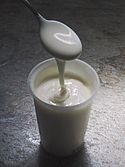 |
A milk-based product similar to cream cheese, made in Brazil. It's a creamy spread that tastes a bit like ricotta. |
| Rissole |
|
In Brazil, rissoles are often filled with sweetcorn, cheese, chicken, or shrimp. They are a type of salgado. |
| Salgado or salgadinho |
 |
These are many different kinds of finger foods. They can be small for parties or larger for snacks, usually made of dough wrapped around chopped meat, chicken, ham, or cheese. |
| Tapioca |
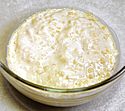 |
A starch taken from the manioc plant. In Brazil, the plant is called "mandioca," and its starch is called "tapioca." It's used in many dishes, both sweet and savory. |
| Torresmo |
 |
These are crispy pork rinds, similar to chicharrón. |
| Name |
Image |
Description |
| Baião de dois |
 |
A Brazilian dish made with rice, beans, and other ingredients. It comes from the state of Ceará and is often served with seafood or dried meat. |
| Bobó de camarão |
 |
A Brazilian dish featuring shrimp in a creamy purée made from manioc flour, coconut milk, and other ingredients. It's flavored with palm oil (dendê) and usually served with white rice. |
| Caldeirada |
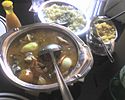 |
A Portuguese fish stew with various types of fish and potatoes. In Brazil, it's known as a flavorful stew of river fish and cilantro. |
| Carne-de-sol |
 |
This means "sun-dried meat." It's heavily salted beef that's left in the sun for a day or two to cure. It's a popular dish in Northeastern Brazil. |
| Caruru |
 |
Made from okra, onion, shrimp, palm oil, and toasted nuts (peanuts or cashews). It's a typical sauce or side dish in the state of Bahia. |
| Chouriço doce |
|
A type of blood sausage made with pig blood, brown sugar or honey, cashew nuts, and spices. |
| Churrasco |
 |
In Brazil, churrasco is the word for barbecue. It involves grilling various meats like pork, sausage, and chicken on a special grill. A churrascaria is a restaurant where waiters bring skewers of grilled meat to your table and slice it for you. |
| Arroz de coco (coconut rice) |
 |
White rice cooked with coconut milk or coconut flakes, giving it a rich, creamy flavor. |
| Cuscuz |
 |
In Brazil, traditional couscous is made from cornmeal. There's also a white version called cuscuz branco. |
| Feijoada |
 |
A hearty stew of beans with beef and pork. It's similar to stews found in other former Portuguese colonies. |
| Galinhada |
 |
A stew of rice with chicken, a classic Brazilian dish from the state of Goiás. |
| Maniçoba |
|
A special dish from the Amazon region, originally from indigenous people. It's made with manioc plant leaves, salted pork, dried meat, and smoked ingredients like bacon or sausage. |
| Mocotó |
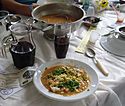 |
Made from cow's feet, stewed with beans and vegetables. The name comes from the Tupi language. |
| Moqueca |
 |
A delicious seafood stew with two main versions: Moqueca baiana (from Bahia, using palm oil) and Moqueca Capixaba (from Espírito Santo, using olive oil). |
| Pato no tucupi |
|
A traditional Brazilian dish from the Amazon region, especially around Belém. It features boiled duck (pato) in tucupi sauce. |
| Piracuí |
|
Known in the Amazon region as "fish meal," it's traditionally made from a dried, ground fish called bodó. |
| Arroz e feijão (rice and beans) |
 |
Rice and beans are a staple in Brazil. Different regions prefer different types of beans. Black beans are popular in Rio de Janeiro and the southern states. |
| Sarapatel |
|
A dish of Portuguese origin, now common in northeastern Brazil. It includes meat and offal (organs) from pork, and sometimes beef. |
| Sopa de mondongo |
 |
A soup from Latin America made from diced tripe (cow's stomach) slow-cooked with vegetables like bell peppers, onions, carrots, and tomatoes. |
| Tacacá |
|
A soup common in North Brazil. It's made with jambu (a native plant), tucupi (a broth from wild manioc), dried shrimp, and small yellow peppers. |
| Tucupi |
|
A yellow sauce extracted from wild manioc root in Brazil's Amazon jungle. The raw juice is toxic, so it must be cooked properly. |
| Vatapá |
 |
Made with bread, shrimp, coconut milk, finely ground peanuts, and palm oil, all mashed into a creamy paste. It's very popular in the North and Northeast, especially in Bahia, where it's often eaten with acarajé. |
| Name |
Image |
Description |
| Beijinho |
 |
Beijinho means "little kiss." It's a typical Brazilian birthday party candy made with condensed milk and grated coconut. It's like a coconut version of the brigadeiro, often topped with a dried clove. |
| Brigadeiro |
 |
A simple Brazilian chocolate bonbon, often served at birthday parties. It's made by mixing sweetened condensed milk, butter, and cocoa powder, then rolled in chocolate sprinkles. |
| Doce de leite |
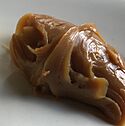 |
A traditional Latin American sweet made from milk and sugar. It can be a thick spread or cut into solid cubes. |
| Mousse de maracujá |
 |
A light and airy mousse made with passion fruit pulp and seeds. |
| Paçoca |
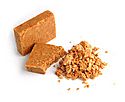 |
There are two very different Brazilian foods called paçoca. In Northeastern Brazil, it's a dish of sun-dried beef, cassava flour, and red onions, ground together. In other regions, it's a candy made from ground peanuts and sugar pressed together. |
| Pamonha |
 |
A traditional Brazilian food, it's a paste made from fresh corn and milk, boiled wrapped in corn husks, turned into a dumpling. Variations include pamonha de milho and pamonha de carimã, and some variants use coconut milk. |
| Pé-de-moleque |
 |
This is a traditional candy similar to peanut brittle. It's made by mixing roasted peanuts with melted brown sugar or molasses. |
| Pudim |
 |
A creamy custard dessert with caramel sauce, very common in Brazil. It's similar to flan. |
| Quindim |
 |
A bright yellow Brazilian baked custard made mainly from sugar, egg yolks, and ground coconut. |
| Rabanada |
 |
A sweet version of French toast, covered with sugar and cinnamon powder. It's usually served during Christmas. |
| Romeu e Julieta |
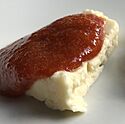 |
"Romeo and Juliet" is a simple but delicious combination of Minas cheese with goiabada (guava paste). |
| Sweet rice |
 |
Brazilian sweet rice or rice pudding is made with milk, sometimes coconut milk, sugar, condensed milk, and cinnamon. |
| Tareco |
 |
A firm biscuit made from wheat flour, eggs, and sugar. When baked, it forms a disk shape. |






















